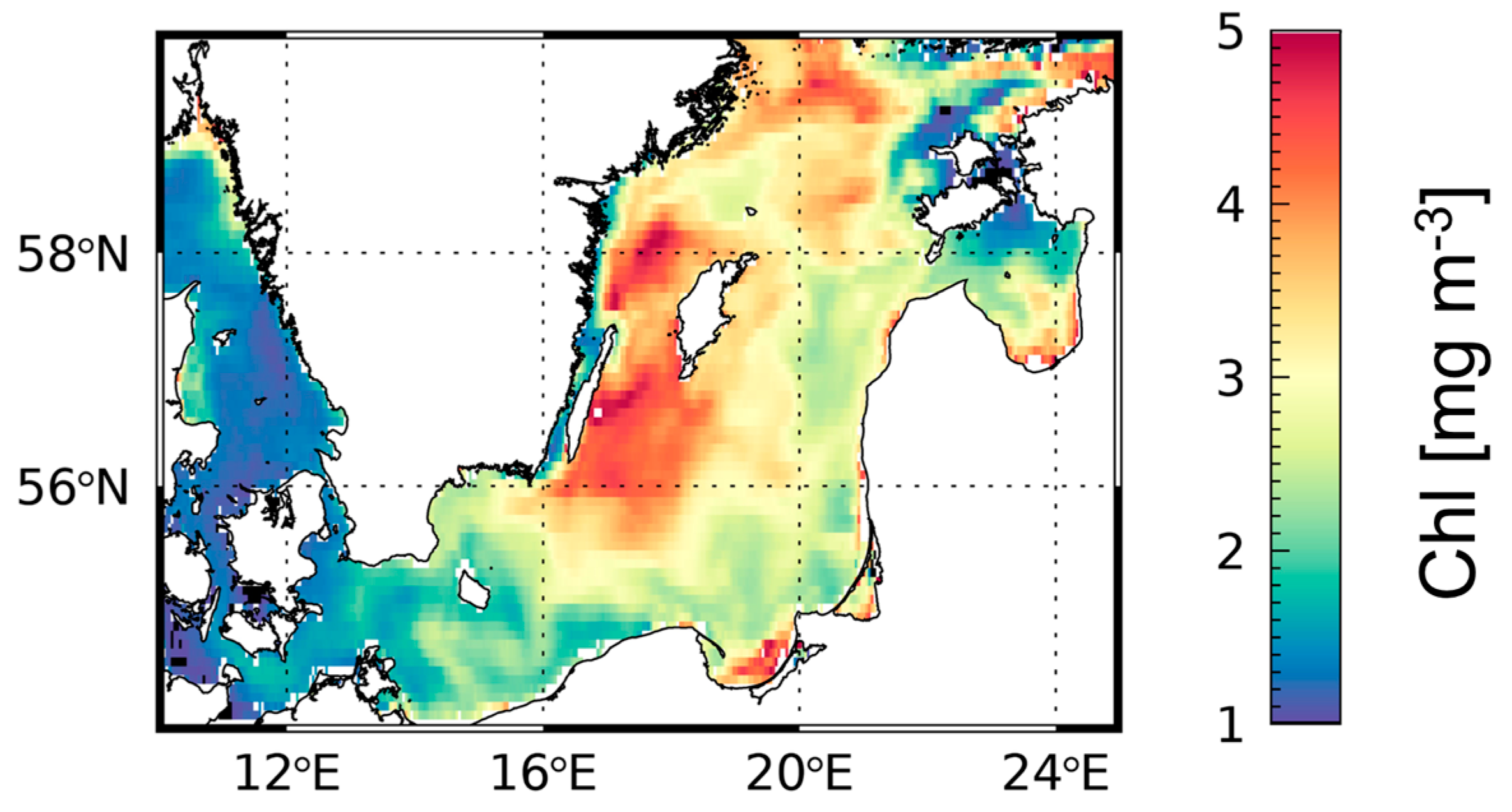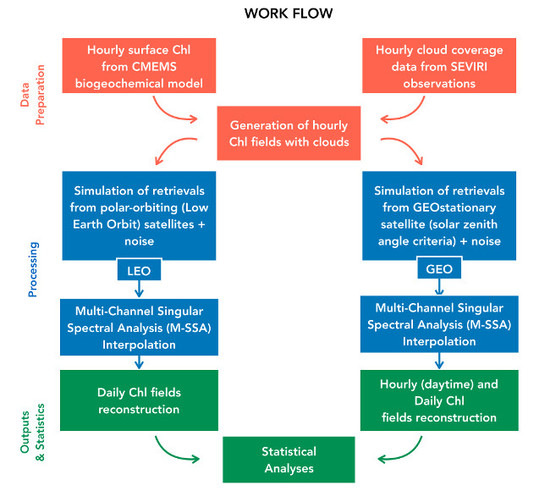Assessing the Potential Benefits of the Geostationary Vantage Point for Generating Daily Chlorophyll-a Maps in the Baltic Sea
Abstract
:1. Introduction
2. Materials and Methods
- Data preparation:
- ○
- Hourly surface Chl data of the biogeochemical model were extracted together with the hourly SEVIRI cloud masks.
- ○
- The Chl hourly fields were re-mapped on the SEVIRI observation grid.
- ○
- The hourly cloud masks were then overlaid on the hourly surface Chl fields.
- Processing:
- ○
- Simulation of a GEO sensor using the solar zenith angle criteria (see Section 2.3).
- ○
- Simulation of a LEO ocean color sensor, using the expected sampling time of the Sentinel-3A satellite over the study area. For simplicity, we have provided an over-sampling of a real LEO observations as we have included all the modelled Chl data that could potentially be beyond the swath of the sensor.
- ○
- A Gaussian noise was added on each single Chl data.
- Outputs and statistics:
2.1. Hourly Chl Simulated Data
2.2. Hourly Clouds Data
2.3. Simulating GEO and LEO Retrievals
2.4. Multi-Channel Singular Spectral Analysis (M-SSA)
2.5. Statistical Indicators
- (i)
- The number of available simulations for the entire month for each pixel. This index directly allows us to quantify the potential observations as captured using a LEO versus GEO ocean color sensors;
- (ii)
- the bias and root mean square error between the original Chl and the gap-free reconstructed fields (in both the LEO and GEO cases) for diel Chl reconstructions and mean Chl daytime fields:
3. Results and Discussion
3.1. Chl Spatial–Temporal Distribution
3.2. Spatial-Temporal Coverage
3.3. Hourly Reconstruction
3.4. Mean Daytime Reconstruction
4. Conclusions and Final Remarks
Author Contributions
Funding
Acknowledgments
Conflicts of Interest
References
- Martinez, E.; Antoine, D.; D’Ortenzio, F.; Gentili, B. Climate-driven basin-scale decadal oscillations of oceanic phytoplankton. Science 2009, 326, 1253–1256. [Google Scholar] [CrossRef] [PubMed]
- Behrenfeld, M.J.; O’Malley, R.T.; Boss, E.S.; Westberry, T.K.; Graff, J.R.; Halsey, K.H.; Milligan, A.J.; Siegel, D.A.; Brown, M.B. Revaluating ocean warming impacts on global phytoplankton. Nat. Clim. Chang. 2016, 6, 323. [Google Scholar] [CrossRef]
- Organelli, E.; Claustre, H.; Bricaud, A.; Schmechtig, C.; Poteau, A.; Xing, X.; Prieur, L.; D’Ortenzio, F.; Dall’Olmo, G.; Vellucci, V. A novel near-real-time quality-control procedure for radiometric profiles measured by Bio-Argo floats: Protocols and performances. J. Atmos. Ocean. Technol. 2016, 33, 937–951. [Google Scholar] [CrossRef]
- Barbieux, M.; Uitz, J.; Bricaud, A.; Organelli, E.; Poteau, A.; Schmechtig, C.; Gentili, B.; Obolensky, G.; Leymarie, E.; Penkerc’h, C.; D’Ortenzio, F. Assessing the Variability in the Relationship between the Particulate Backscattering Coefficient and the Chlorophyll a Concentration from a Global Biogeochemical-Argo Database. J. Geophys. Res. Oceans 2018, 123, 1229–1250. [Google Scholar] [CrossRef]
- Antoine, D.; D’Ortenzio, F.; Hooker, S.B.; Becu, G.; Gentili, B.; Tailliez, D.; Scott, A.J. Assessment of uncertainty in the ocean reflectance determined by three satellite ocean color sensors (MERIS, SeaWiFS and MODIS-A) at an offshore site in the Mediterranean Sea (BOUSSOLE project). J. Geophys. Res. 2008, 113, C07013. [Google Scholar] [CrossRef]
- Antoine, D.; Guevel, P.; Deste, J.F.; Becu, G.; Louis, F.; Scott, A.J.; Bardey, P. The ‘‘BOUSSOLE’’ buoy—A new transparent-to-swell taut mooring dedicated to marine optics: Design, tests, and performance at sea. J. Atmos. Oceanic Technol. 2008, 25, 968–989. [Google Scholar] [CrossRef]
- Antoine, D.; Siegel, D.A.; Kostadinov, T.; Maritorena, S.; Nelson, N.B.; Gentili, B.; Vellucci, V.; Guillocheau, N. Variability in optical particle backscattering in contrasting bio-optical oceanic regimes. Limnol. Oceanogr. 2011, 56, 955–973. [Google Scholar] [CrossRef] [Green Version]
- Volpe, G.; Nardelli, B.B.; Colella, S.; Santoleri, R. An Operational Interpolated Ocean Colour Product in the Mediterranean Sea. In GODAE Oceanview International School in “New Frontiers in Operational Oceanography”; Chassignet, E.P., Pascual, A., Tintore, J., Verron, J., Eds.; GODAE OceanView, 2018; pp. 227–244. [Google Scholar] [CrossRef]
- Neveux, J.; Dupouy, C.; Blanchot, J.; Le Bouteiller, A.; Landry, M.R.; Brown, S.L. Diel dynamics of chlorophylls in high-nutrient, low-chlorophyll waters of the equatorial Pacific (180°): Interactions of growth, grazing, physiological responses, and mixing. J. Geophys. Res. Oceans 2003, 108. [Google Scholar] [CrossRef] [Green Version]
- Oubelkheir, K.; Sciandra, A. Diel variations in particle stocks in the oligotrophic waters of the Ionian Sea (Mediterranean). J. Mar. Syst. 2008, 74, 364–371. [Google Scholar] [CrossRef]
- Dall’Olmo, G.; Boss, E.; Behrenfeld, M.J.; Westberry, T.K.; Courties, C.; Prieur, L.; Pujo-Pay, M.; Hardman-Mountford, N.; Moutin, T. Inferring phytoplankton carbon and eco-physiological rates from diel cycles of spectral particulate beam-attenuation coefficient. Biogeosciences 2011, 8, 3423–3439. [Google Scholar] [CrossRef]
- Loisel, H.; Vantrepotte, V.; Norkvist, K.; Meriaux, X.; Kheireddine, M.; Ras, J.; Pujo-Pay, M.; Combet, Y.; Leblanc, K.; Dall’Olmo, G.; et al. Characterization of the bio-optical anomaly and diurnal variability of particulate matter, as seen from scattering and backscattering coefficients, in ultra-oligotrophic eddies of the Mediterranean Sea. Biogeosciences 2011, 8, 3295–3317. [Google Scholar] [CrossRef] [Green Version]
- Gernez, P.; Antoine, D.; Huot, Y. Diel cycles of the particulate beam attenuation coefficient under varying trophic conditions in the northwestern Mediterranean Sea: Observations and modeling. Limnol. Oceanogr. 2011, 56, 17–36. [Google Scholar] [CrossRef]
- Barnes, M.; Antoine, D. Proxies of community production derived from the diel variability of particulate attenuation and backscattering coefficients in the northwest Mediterranean Sea. Limnol. Oceanogr. 2014, 59, 2133–2149. [Google Scholar] [CrossRef]
- Kheireddine, M.; Antoine, D. Diel variability of the beam attenuation and backscattering coefficients in the northwestern Mediterranean Sea (BOUSSOLE site). J. Geophys. Res. Oceans 2014, 119, 5465–5482. [Google Scholar] [CrossRef] [Green Version]
- Poulin, C.; Antoine, D.; Huot, Y. Diurnal variations of the optical properties of phytoplankton in a laboratory experiment and their implication for using inherent optical properties to measure biomass. Opt. Express 2018, 26, 711–729. [Google Scholar] [CrossRef]
- Constantin, S.; Doxaran, D.; Derkacheva, A.; Novoa, S.; Lavigne, H. Multi-temporal dynamics of suspended particulate matter in a macro-tidal river Plume (the Gironde) as observed by satellite data. Estuar. Coast. Shelf Sci. 2018, 202, 172–184. [Google Scholar] [CrossRef]
- Stramska, M.; Dickey, T.D. Variability of bio-optical properties of the upper ocean associated with diel cycles in phytoplankton population. J. Geophys. Res. 1992, 97, 17873–17887. [Google Scholar] [CrossRef]
- Arnone, R.A.; Vandermeulen, R.A.; Soto, I.M.; Ladner, S.D.; Ondrusek, M.E.; Yang, H. Diurnal changes in ocean color sensed in satellite imagery. J. Appl. Remote Sens. 2017, 11, 032406. [Google Scholar] [CrossRef] [Green Version]
- IOCCG. Ocean-Colour Observations from a Geostationary Orbit. In Reports of the International Ocean-Colour Coordinating Group; Antoine, D., Ed.; No. 12; IOCCG: Dartmouth, NS, Canada, 2012. [Google Scholar]
- Neukermans, G.; Ruddick, K.G.; Greenwood, N. Diurnal variability of turbidity and light attenuation in the southern North Sea from the SEVIRI geostationary sensor. Remote Sens. Environ. 2012, 124, 564–580. [Google Scholar] [CrossRef]
- Ruddick, K.; Neukermans, G.; Vanhellemont, Q.; Jolivet, D. Challenges and opportunities for geostationary ocean colour remote sensing of regional seas: A review of recent results. Remote Sens. Environ. 2014, 146, 63–76. [Google Scholar] [CrossRef]
- Marullo, S.; Santoleri, R.; Banzon, V.; Evans, R.H.; Guarracino, M. A diurnal-cycle resolving sea surface temperature product for the tropical Atlantic. J. Geophys. Res. Oceans 2010, 115. [Google Scholar] [CrossRef] [Green Version]
- Marullo, S.; Santoleri, R.; Ciani, D.; Le Borgne, P.; Péré, S.; Pinardi, N.; Tonani, M.; Nardone, G. Combining model and geostationary satellite data to reconstruct hourly SST field over the Mediterranean Sea. Remote Sens. Environ. 2014, 146, 11–23. [Google Scholar] [CrossRef]
- Marullo, S.; Minnett, P.J.; Santoleri, R.; Tonani, M. The diurnal cycle of sea-surface temperature and estimation of the heat budget of the Mediterranean Sea. J. Geophys. Res. Oceans 2016, 121, 8351–8367. [Google Scholar] [CrossRef]
- Lamquin, N.; Mazeran, C.; Doxaran, D.; Ryu, J.H.; Park, Y.J. Assessment of GOCI radiometric products using MERIS, MODIS and field measurements. Ocean Sci. J. 2012, 47, 287–311. [Google Scholar] [CrossRef]
- Wang, M.; Ahn, J.H.; Jiang, L.; Shi, W.; Son, S.; Park, Y.J.; Ryu, J.H. Ocean color products from the Korean geostationary ocean color imager (GOCI). Opt. Express 2013, 21, 3835–3849. [Google Scholar] [CrossRef] [PubMed]
- Lou, X.; Hu, C. Diurnal changes of a harmful algal bloom in the East China Sea: Observations from GOCI. Remote Sens. Environ. 2014, 140, 562–572. [Google Scholar] [CrossRef]
- Choi, J.K.; Park, Y.J.; Lee, B.R.; Eom, J.; Moon, J.E.; Ryu, J.H. Application of the Geostationary Ocean Color Imager (GOCI) to mapping the temporal dynamics of coastal water turbidity. Remote Sens. Environ. 2014, 146, 24–35. [Google Scholar] [CrossRef]
- Amin, R.; Lewis, M.D.; Lawson, A.; Gould Jr, R.W.; Martinolich, P.; Li, R.R.; Ladner, S.; Gallegos, S. Comparative Analysis of GOCI Ocean Color Products. Sensors 2015, 15, 25703–25715. [Google Scholar] [CrossRef] [Green Version]
- Jiang, L.; Wang, M. Diurnal Currents in the Bohai Sea Derived from the Korean Geostationary Ocean Color Imager. IEEE Trans. Geosci. Remote Sens. 2017, 55, 1437–1450. [Google Scholar] [CrossRef]
- Ghil, M.; Allen, M.R.; Dettinger, M.D.; Ide, K.; Kondrashov, D.; Mann, M.E.; Robertson, A.W.; Saunders, A.; Tian, Y.; Varadi, F.; et al. Advanced spectral methods for climatic time series. Rev. Geophys. 2002, 40, 3-1–3-41. [Google Scholar] [CrossRef] [Green Version]
- Kondrashov, D.; Ghil, M. Spatio-temporal filling of missing points in geophysical data sets. Nonlinear Processes Geophys. 2006, 13, 151–159. [Google Scholar] [CrossRef] [Green Version]
- Wang, M.; Gordon, H.R. Calibration of ocean color scanners: How much error is acceptable in the near infrared? Remote Sens. Environ. 2002, 82, 497–504. [Google Scholar] [CrossRef]
- Gregg, W.W.; Casey, N.W. Sampling biases in MODIS and SeaWiFS ocean chlorophyll data. Remote Sens. Environ. 2007, 111, 25–35. [Google Scholar] [CrossRef] [Green Version]
- Barbu, T. Variational image denoising approach with diffusion porous media flow. In Abstract and Applied Analysis; Hindawi: Cairo, Egypt, 2013. [Google Scholar]
- Beckers, J.M.; Rixen, M. EOF calculations and data filling from incomplete oceanographic datasets. J. Atmos. Ocean. Technol. 2003, 20, 1839–1856. [Google Scholar] [CrossRef]
- Wan, Z.; Jonasson, L.; Bi, H. N/P ratio of nutrient uptake in the Baltic Sea. Ocean Sci. 2011, 7, 693–704. [Google Scholar] [CrossRef] [Green Version]
- Pitarch, J.; Volpe, G.; Colella, S.; Krasemann, H.; Santoleri, R. Remote sensing of chlorophyll in the Baltic Sea at basin scale from 1997 to 2012 using merged multi-sensor data. Ocean Sci. 2016, 12, 379–389. [Google Scholar] [CrossRef]
- Schneider, B.; Kaitala, S.; Maunula, P. Identification and quantification of plankton bloom events in the Baltic Sea by continuous pCO2 and chlorophyll-a measurements on a cargo ship. J. Mar. Syst. 2006, 59, 238–248. [Google Scholar] [CrossRef]
- Reissmann, J.H.; Burchard, H.; Feistel, R.; Hagen, E.; Lass, H.U.; Mohrholz, V.; Nausch, G.; Umlauf, L.; Wieczorek, G. Vertical mixing in the Baltic Sea and consequences for eutrophication—A review. Prog. Oceanogr. 2009, 82, 47–80. [Google Scholar] [CrossRef]








© 2018 by the authors. Licensee MDPI, Basel, Switzerland. This article is an open access article distributed under the terms and conditions of the Creative Commons Attribution (CC BY) license (http://creativecommons.org/licenses/by/4.0/).
Share and Cite
Bellacicco, M.; Ciani, D.; Doxaran, D.; Vellucci, V.; Antoine, D.; Wang, M.; D’Ortenzio, F.; Marullo, S. Assessing the Potential Benefits of the Geostationary Vantage Point for Generating Daily Chlorophyll-a Maps in the Baltic Sea. Remote Sens. 2018, 10, 1944. https://doi.org/10.3390/rs10121944
Bellacicco M, Ciani D, Doxaran D, Vellucci V, Antoine D, Wang M, D’Ortenzio F, Marullo S. Assessing the Potential Benefits of the Geostationary Vantage Point for Generating Daily Chlorophyll-a Maps in the Baltic Sea. Remote Sensing. 2018; 10(12):1944. https://doi.org/10.3390/rs10121944
Chicago/Turabian StyleBellacicco, Marco, Daniele Ciani, David Doxaran, Vincenzo Vellucci, David Antoine, Menghua Wang, Fabrizio D’Ortenzio, and Salvatore Marullo. 2018. "Assessing the Potential Benefits of the Geostationary Vantage Point for Generating Daily Chlorophyll-a Maps in the Baltic Sea" Remote Sensing 10, no. 12: 1944. https://doi.org/10.3390/rs10121944






